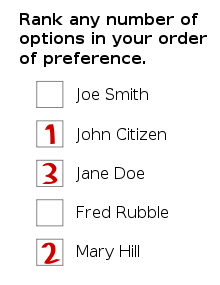
Back صوت واحد قابل للتحويل Arabic Votu únicu tresferible AST Vot únic transferible Catalan Systém jednoho přenosného hlasu Czech Pleidlais sengl drosglwyddadwy Welsh Übertragbare Einzelstimmgebung German Μεταφερόμενη μονοσταυρία Greek Unuopa transdonebla voĉdono Esperanto Voto único transferible Spanish تکرأی انتقالپذیر Persian

| Part of the Politics series |
| Electoral systems |
|---|
 |
|
|

The single transferable vote (STV), sometimes known as proportional ranked choice voting (P-RCV),[a] is a multi-winner electoral system in which each voter casts a single vote in the form of a ranked-choice ballot. Voters have the option to rank candidates, and their vote may be transferred according to alternate preferences if their preferred candidate is eliminated or elected with surplus votes, so that their vote is used to elect someone they prefer over others in the running. STV aims to approach proportional representation based on votes cast in the district where it is used, so that each vote is worth about the same as another.
Under STV, no one party or voting bloc can take all the seats in a district unless the number of seats in the district is very small or almost all the votes cast are cast for one party's candidates (which is seldom the case). This makes it different from other commonly used candidate-based systems. In majoritarian or plurality systems – such as first-past-the-post (FPTP), instant-runoff voting (IRV), block voting, and ranked-vote block voting – one party or voting bloc can take all the seats in a district.
The key to STV's approximation of proportionality is that each voter effectively only casts a single vote in a district contest electing multiple winners, while the ranked ballots (and sufficiently large districts) allow the results to approach proportionality. The use of a quota means that, for the most part, each successful candidate is elected with the same number of votes. This equality produces fairness in the particular sense that a party taking twice as many votes as another party will generally take twice the number of seats compared to that other party.
Under STV, multiple winners are selected for a constituency (a multi-member district). Every sizeable group within the district wins at least one seat: the more seats the district has, the smaller the size of the group needed to elect a member. In this way, STV provides approximately proportional representation, ensuring that substantial minority factions have some representation.
STV is distinguished from plurality voting systems – like FPTP, plurality block voting and the single non-transferable vote (SNTV) – by the fact that votes are transferable under STV but are not under the other systems. STV reduces the number of "wasted" votes, votes which are cast for unsuccessful candidates, by electing multiple representatives for a district. As well, a vote initially cast for an unelectable candidate may be transferred to a candidate with a higher chance of being elected. Additionally, surplus votes collected by successful candidates are transferred to aid other candidates, preventing waste caused by successful candidates receiving votes over and above those actually needed to secure the seat.
An important characteristic of STV is that it enables votes to be cast for individual candidates rather than for parties. Party lists are therefore not needed (as opposed to many other proportional electoral systems); it is the voters who create their own ordered list of candidates. The ranked voting also allows voters to form consensus behind the most popular candidates.[1]
Cite error: There are <ref group=lower-alpha> tags or {{efn}} templates on this page, but the references will not show without a {{reflist|group=lower-alpha}} template or {{notelist}} template (see the help page).
- ^ "Single Transferable Vote". Electoral Reform Society.
© MMXXIII Rich X Search. We shall prevail. All rights reserved. Rich X Search